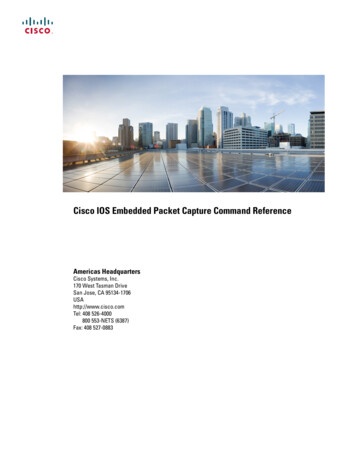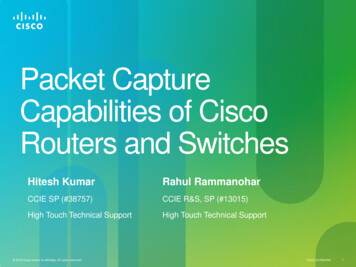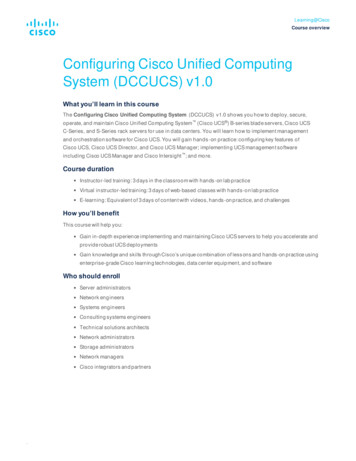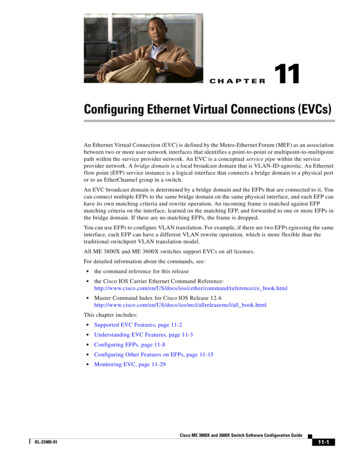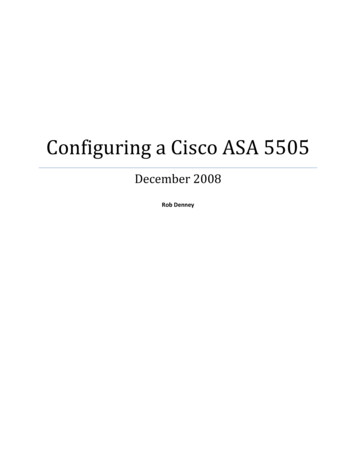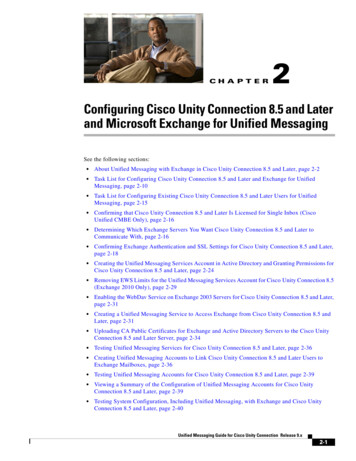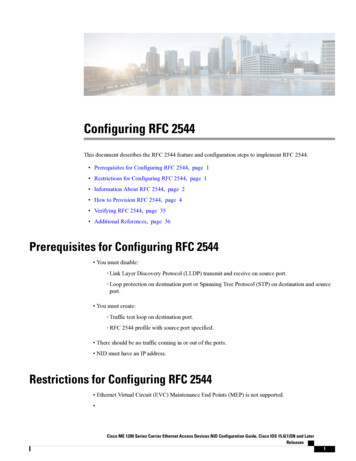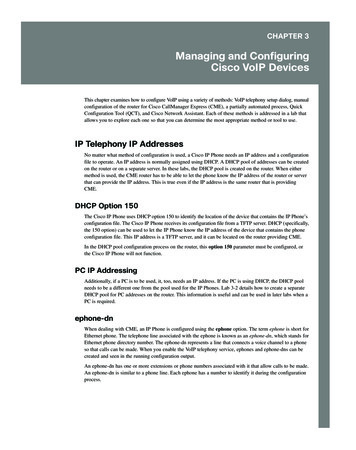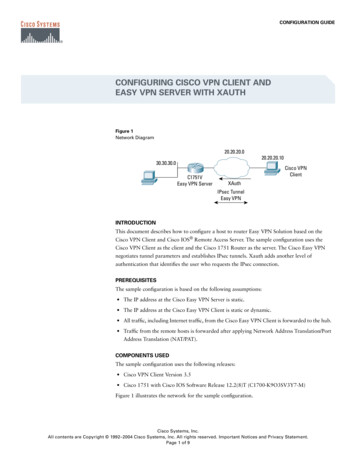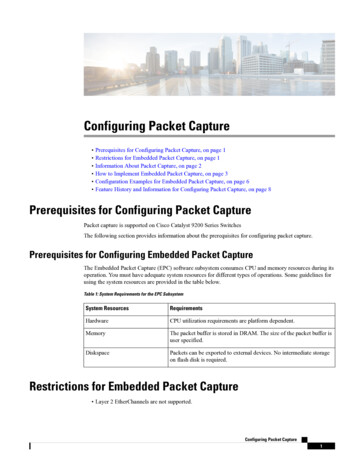
Transcription
Configuring Packet Capture Prerequisites for Configuring Packet Capture, on page 1 Restrictions for Embedded Packet Capture, on page 1 Information About Packet Capture, on page 2 How to Implement Embedded Packet Capture, on page 3 Configuration Examples for Embedded Packet Capture, on page 6 Feature History and Information for Configuring Packet Capture, on page 8Prerequisites for Configuring Packet CapturePacket capture is supported on Cisco Catalyst 9200 Series SwitchesThe following section provides information about the prerequisites for configuring packet capture.Prerequisites for Configuring Embedded Packet CaptureThe Embedded Packet Capture (EPC) software subsystem consumes CPU and memory resources during itsoperation. You must have adequate system resources for different types of operations. Some guidelines forusing the system resources are provided in the table below.Table 1: System Requirements for the EPC SubsystemSystem ResourcesRequirementsHardwareCPU utilization requirements are platform dependent.MemoryThe packet buffer is stored in DRAM. The size of the packet buffer isuser specified.DiskspacePackets can be exported to external devices. No intermediate storageon flash disk is required.Restrictions for Embedded Packet Capture Layer 2 EtherChannels are not supported.Configuring Packet Capture1
Configuring Packet CaptureInformation About Packet Capture Neither VRFs, management ports, nor private VLANs can be used as attachment points. Embedded Packet Capture (EPC) is not supported on logical ports, which includes port channels, switchvirtual interfaces (SVIs), and subinterfaces. It is supported only on physical ports. If the user changes interface from switch port to routed port (Layer 2 to Layer 3) or vice versa, they mustdelete the capture point and create a new one, once the interface comes back up. Stop/start the capturepoint will not work. Packets captured in the output direction of an interface might not reflect the changes made by the devicerewrite (includes TTL, VLAN tag, CoS, checksum, MAC addresses, DSCP, precedent, UP, etc.). Even though the minimum configurable duration for packet capture is 1 second, packet capture worksfor a minimum of 2 seconds. It is not possible to modify a capture point parameter when a capture is already active or has started. EPC captures multicast packets only on ingress and does not capture the replicated packets on egress. The Rewrite information of both ingress and egress packets are not captured. CPU-injected packets are considered control plane packets. Therefore, these types of packets will not becaptured on an interface egress capture. Control plane packets are not rate limited and performance impacting. Please use filters to limit controlplane packet capture. Decoding of protocols such as Control and Provisioning of Wireless Access Points (CAPWAP) issupported in DNA Advantage. Up to 8 capture points can be defined, but only one can be active at a time. You need to stop one beforeyou can start the other. MAC filter will not capture IP packets even if it matches the MAC address. This applies to all interfaces(Layer 2 switch port, Layer 3 routed port) MAC ACL is only used for non-IP packets such as ARP. It will not be supported on a Layer 3 port orSVI. MAC filter cannot capture Layer 2 packets (ARP) on Layer 3 interfaces. IPv6-based ACLs are not supported in VACL.Information About Packet CaptureThe Packet Capture feature is an onboard packet capture facility that allows network administrators to capturepackets flowing to, through, and from the device and to analyze them locally or save and export them foroffline analysis by using Embedded Packet Capture (EPC). This feature simplifies network operations byallowing devices to become active participants in the management and operation of the network. This featurefacilitates troubleshooting by gathering information about the packet format. This feature also facilitatesapplication analysis and security.Configuring Packet Capture2
Configuring Packet CaptureAbout Embedded Packet CaptureAbout Embedded Packet CaptureEPC provides an embedded systems management facility that helps in tracing and troubleshooting packets.This feature allows network administrators to capture data packets flowing through, to, and from a Ciscodevice. The network administrator may define the capture buffer size and type (circular, or linear) and themaximum number of bytes of each packet to capture. The packet capture rate can be throttled using furtheradministrative controls. For example, options allow for filtering the packets to be captured using an AccessControl List and, optionally, further defined by specifying a maximum packet capture rate or by specifyinga sampling interval.Benefits of Embedded Packet Capture Ability to capture IPv4 and IPv6 packets in the device, and also capture non-IP packets with MAC filteror match any MAC address. Extensible infrastructure for enabling packet capture points. A capture point is a traffic transit pointwhere a packet is captured and associated with a buffer. Facility to export the packet capture in packet capture file (PCAP) format suitable for analysis using anyexternal tool. Methods to decode data packets captured with varying degrees of detail.Packet Data CapturePacket data capture is the capture of data packets that are then stored in a buffer. You can define packet datacaptures by providing unique names and parameters.You can perform the following actions on the capture: Activate captures at any interface. Apply access control lists (ACLs) or class maps to capture points.NoteNetwork Based Application Recognition (NBAR) and MAC-style class map isnot supported. Destroy captures. Specify buffer storage parameters such as size and type. The size ranges from 1 MB to 100 MB. Thedefault buffer is linear;; the other option for the buffer is circular. Specify match criteria that includes information about the protocol, IP address or port address.How to Implement Embedded Packet CaptureThe following sections provide information on how to implement EPC.Configuring Packet Capture3
Configuring Packet CaptureManaging Packet Data CaptureManaging Packet Data CaptureTo manage Packet Data Capture in the buffer mode, perform the following steps:ProcedureStep 1Command or ActionPurposeenableEnables privileged EXEC mode.Example:Enter your password if prompted.Device enableStep 2monitor capture capture-name access-listaccess-list-nameExample:Configures a monitor capture specifying anaccess list as the core filter for the packetcapture.Device# monitor capture mycap access-listv4aclStep 3monitor capture capture-name limit duration Configures monitor capture limits.secondsExample:Device# monitor capture mycap limitduration 1000Step 4monitor capture capture-name interfaceinterface-name bothConfigures monitor capture specifying anattachment point and the packet flow direction.Example:Device# monitor capture mycap interfaceGigabitEthernet 0/0/1 bothStep 5monitor capture capture-name buffer circular Configures a buffer to capture packet data.size bytesExample:Device# monitor capture mycap buffercircular size 10Step 6monitor capture capture-name startExample:Starts the capture of packet data at a traffic tracepoint into a buffer.Device# monitor capture mycap startStep 7monitor capture capture-name stopExample:Device# monitor capture mycap stopConfiguring Packet Capture4Stops the capture of packet data at a traffic tracepoint.
Configuring Packet CaptureMonitoring and Maintaining Captured DataStep 8Command or ActionPurposemonitor capture capture-name export file-location/file-nameExports captured data for analysis.Example:Device# monitor capture mycap exporttftp://10.1.88.9/mycap.pcapStep 9endReturns to privileged EXEC mode.Example:Device# endMonitoring and Maintaining Captured DataPerform this task to monitor and maintain the packet data captured. Capture buffer details and capture pointdetails are displayed.ProcedureStep 1Command or ActionPurposeenableEnables privileged EXEC mode.Example:Enter your password if prompted.Device enableStep 2show monitor capture capture-buffer-namebuffer dump(Optional) Displays a hexadecimal dump ofcaptured packet and its metadata.Example:Device# show monitor capture mycap bufferdumpStep 3show monitor capture capture-buffer-nameparameter(Optional) Displays a list of commands thatwere used to specify the capture.Example:Device# show monitor capture mycapparameterStep 4debug epc capture-pointExample:(Optional) Enables packet capture pointdebugging.Device# debug epc capture-pointStep 5debug epc provisionExample:(Optional) Enables packet capture provisioningdebugging.Configuring Packet Capture5
Configuring Packet CaptureConfiguration Examples for Embedded Packet CaptureCommand or ActionPurposeDevice# debug epc provisionStep 6Returns to privileged EXEC mode.endExample:Device(config)# endConfiguration Examples for Embedded Packet CaptureExample: Managing Packet Data CaptureThe following example shows how to manage packet data capture:Device cess-list v4acllimit duration 1000interface GigabitEthernet 0/0/1 bothbuffer circular size 10startexport tftp://10.1.88.9/mycap.pcapstopExample: Monitoring and Maintaining Captured DataThe following example shows how to dump packets in ASCII format:Device# show monitor capture mycap buffer dumpStarting the packet display . Press Ctrl Shift 6 to 00080045C0 . .E.0002E000 .0.10030AFA .*.0001 .example.01005E00 0002001B 2BF69280 080046C0 . . .F.00200000 00000102 44170000 0000E000 . .D.00019404 00001700 E8FF0000 0000 045C0 . . .E.0003E000 .0.08030A6E .n0001 1000000Configuring Packet Capture60C07AC1DCFDC091D802A00000000091D. .E. .X.
Configuring Packet CaptureExample: Monitoring and Maintaining Captured DataThe following example shows how to display the list of commands used to configure the capture namedmycap:Device#monitormonitormonitormonitorshow monitor capture mycap parametercapture mycap interface GigabitEthernet 1/0/1 bothcapture mycap match anycapture mycap buffer size 10capture mycap limit pps 1000The following example shows how to debug the capture point:Device# debug epc capture-pointEPC capture point operations debugging is onDevice# monitor capture mycap start*Jun 4 14:17:15.463: EPC CP: Starting the capture cap1*Jun 4 14:17:15.463: EPC CP: (brief 3, detailed 4, dump 5) 0*Jun 4 14:17:15.463: EPC CP: final check before activation*Jun 4 14:17:15.463: EPC CP: setting up c3pl infra*Jun 4 14:17:15.463: EPC CP: Setup c3pl acl-class-policy*Jun 4 14:17:15.463: EPC CP: Creating a class*Jun 4 14:17:15.464: EPC CP: Creating a class : Successful*Jun 4 14:17:15.464: EPC CP: class-map Created*Jun 4 14:17:15.464: EPC CP: creating policy-name epc policy cap1*Jun 4 14:17:15.464: EPC CP: Creating Policy epc policy cap1 of type 49 and client type 21*Jun 4 14:17:15.464: EPC CP: Storing a Policy*Jun 4 14:17:15.464: EPC CP: calling ppm store policy with epc policy*Jun 4 14:17:15.464: EPC CP: Creating Policy : Successful*Jun 4 14:17:15.464: EPC CP: policy-map created*Jun 4 14:17:15.464: EPC CP: creating filter for ANY*Jun 4 14:17:15.464: EPC CP: Adding acl to class : Successful*Jun 4 14:17:15.464: EPC CP: Setup c3pl class to policy*Jun 4 14:17:15.464: EPC CP: Attaching Class to Policy*Jun 4 14:17:15.464: EPC CP: Attaching epc class cap1 to epc policy cap1*Jun 4 14:17:15.464: EPC CP: Attaching Class to Policy : Successful*Jun 4 14:17:15.464: EPC CP: setting up c3pl qos*Jun 4 14:17:15.464: EPC CP: DBG Set packet rate limit to 1000*Jun 4 14:17:15.464: EPC CP: creating action for policy map epc policy cap1 class mapepc class cap1*Jun 4 14:17:15.464: EPC CP: DBG Set packet rate limit to 1000*Jun 4 14:17:15.464: EPC CP: Activating Interface GigabitEthernet1/0/1 direction both*Jun 4 14:17:15.464: EPC CP: Id attached 0*Jun 4 14:17:15.464: EPC CP: inserting into active lists*Jun 4 14:17:15.464: EPC CP: Id attached 0*Jun 4 14:17:15.465: EPC CP: inserting into active lists*Jun 4 14:17:15.465: EPC CP: Activating Vlan*Jun 4 14:17:15.465: EPC CP: Deleting all temp interfaces*Jun 4 14:17:15.465: %BUFCAP-6-ENABLE: Capture Point cap1 enabled.*Jun 4 14:17:15.465: EPC CP: Active Capture 1Device# monitor capture mycap1 stop*Jun 4 14:17:31.963: EPC CP: Stopping the capture cap1*Jun 4 14:17:31.963: EPC CP: Warning: unable to unbind capture cap1*Jun 4 14:17:31.963: EPC CP: Deactivating policy-map*Jun 4 14:17:31.963: EPC CP: Policy epc policy cap1*Jun 4 14:17:31.964: EPC CP: Deactivating policy-map Successful*Jun 4 14:17:31.964: EPC CP: removing povision feature*Jun 4 14:17:31.964: EPC CP: Found action for policy-map epc policy cap1 class-mapepc class cap1*Jun 4 14:17:31.964: EPC CP: cleanning up c3pl infra*Jun 4 14:17:31.964: EPC CP: Removing Class epc class cap1 from Policy*Jun 4 14:17:31.964: EPC CP: Removing Class from epc policy cap1*Jun 4 14:17:31.964: EPC CP: Successfully removed*Jun 4 14:17:31.964: EPC CP: Removing acl mac from class*Jun 4 14:17:31.964: EPC CP: Removing acl from class : SuccessfulConfiguring Packet Capture7
Configuring Packet CaptureFeature History and Information for Configuring Packet 31.965:14:17:31.965:14:17:31.965:EPC CP: Removing all policiesEPC CP: Removing Policy epc policy cap1EPC CP: Removing Policy : SuccessfulEPC CP: Removing class epc class cap1EPC CP: Removing class : Successful%BUFCAP-6-DISABLE: Capture Point cap1 disabled.EPC CP: Active Capture 0The following example shows how to debug the Embedded Packet Capture (EPC) provisioning:Device# debug epc provisionEPC provisionioning debugging is onDevice# monitor capture mycap start*Jun 4 14:17:54.991: EPC PROV: No action found for policy-map epc policy cap1 class-mapepc class cap1*Jun 4 14:17:54.991: EPC PROV:*Jun 4 14:17:54.991: Attempting to install service policy epc policy cap1*Jun 4 14:17:54.992: EPC PROV: Attached service policy to epc idb subblock*Jun 4 14:17:54.992: EPC PROV: Successful. Create feature object*Jun 4 14:17:54.992: EPC PROV:*Jun 4 14:17:54.992: Attempting to install service policy epc policy cap1*Jun 4 14:17:54.992: EPC PROV: Successful. Create feature object*Jun 4 14:17:54.992: %BUFCAP-6-ENABLE: Capture Point cap1 enabled.Device# monitor capture mycap stop*Jun 4 14:18:02.503: EPC PROV: Successful. Remove feature object*Jun 4 14:18:02.504: EPC PROV: Successful. Remove feature object*Jun 4 14:18:02.504: EPC PROV: Destroyed epc idb subblock*Jun 4 14:18:02.504: EPC PROV: Found action for policy-map epc policy cap1 class-mapepc class cap1*Jun 4 14:18:02.504: EPC PROV: Deleting EPC action*Jun 4 14:18:02.504: EPC PROV: Successful. CLASS REMOVE, policy-map epc policy cap1, classepc class cap1*Jun 4 14:18:02.504: %BUFCAP-6-DISABLE: Capture Point cap1 disabled.Feature History and Information for Configuring Packet CaptureThe following table provides release information about the feature or features described in this module. Thistable lists only the software release that introduced support for a given feature in a given software releasetrain. Unless noted otherwise, subsequent releases of that software release train also support that feature.Table 2: Feature Information for Configuring Packet CaptureFeature NameReleasesFeature InformationConfiguring Packet CaptureCisco IOS XE Gibraltar 16.10.1This feature was introduced.Configuring EPC on an interface Cisco IOS XE Amsterdam 17.2.1either in down state or admin state.Configuring Packet Capture8Configuring EPC on an interfacethat is either in down state or admindown state does not affect packetcapture once the interface changesto up state.
show monitor capture capture-buffer-name buffer dump Example: Step2 Device# showmonitorcapturemycapbuffer dump (Optional)Displaysalistofcommandsthat wereusedtospecifythecapture. show monitor capture capture-buffer-name parameter Example: Step3 Device# showmonitorcapturemycap p
